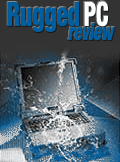

|
|
|
|
|
|
Fujitsu PenCentra 200Speedier and better (November 2000 issue)
When Fujitsu introduced
the PenCentra at DEMOmobile 1999 in San Diego, it was the company's first ever
Windows CE device. At that point, Fujitsu Personal Systems, Inc. (which later was
merged into the Fujitsu PC Corporation) was the undisputed leader in decision
support pen tablets, having grown from virtually zero into a US$100 million
company within just five years. Adding a Windows CE product to FPSI's successful
lineup of Stylistic and Point tablet computers took a bit of a leap of faith,
especially given Microsoft's often inexplicably erratic course with the platform.
Whatever reasons Fujitsu had to build a CE device, the PenCentra certainly was a
terrific first effort. We reviewed the 130 in our October 1999 issue and came
away more than impressed. The PenCentra was one of those rare designs that looked
and felt just "right" from the moment you picked it up. With a footprint of 8.9 x
6.5 inches and weighing about two pounds, it was significantly smaller and
lighter than Fujitsu's Stylistic and Point tablets. Despite its small size,
however, the PenCentra had a surprisingly "grown-up" and businesslike feel to it.
We concluded that the PenCentra was "an incredible value for the money and
another landmark design from Fujitsu Personal Systems."
A year later, the newly
updated PenCentra 200 remains an remarkable device. Its timeless design hasn't
lost its appeal and we were impressed all over by how well this tablet fits into
your hands, how sturdy it is, and just how much functionality Fujitsu managed to
pack into it. When the original PenCentra appeared, it featured more ports and
interfaces than anything else in its class, and that hasn't changed. Along the
top of the PenCentra you find two separate Type II PC Card slots, a 4mbps
infrared port, an alarm on/off button, and an RJ-11 jack for the internal 56k
modem.
Along the right side there is a PS/2-style port for an external keyboard,
a power jack, a USB connector, a full-size 9-pin serial port covered by a plastic
door that snaps securely into place, and standard-size headphone and microphone
jacks. The bottom features high-usage contacts for the optional desktop dock. On
the front, along the right side of the screen, are the microphone, indicator
lights for alarms and power status, and a recorder button.
Like the PenCentra
130, the 200 comes either with a DSTN transmissive or a SSTN reflective 64 x 480
256display. Both measure eight inches diagonally and are limited to 256 colors.
Our test unit had the reflective display which, like all such displays, is a
compromise. It was clearly readable in bright sunlight but didn't fare nearly as
well indoors where the display had noticeably less contrast and sharpness than,
for example, the Compaq iPAQ which also uses a reflective screen. In addition,
the sidelight, which can be adjusted to three levels, cast a distracting
fluorescent glow when viewed at an angle. Unchanged also are the silkscreened
controls along the left side of the screen: screen contrast and backlighting,
right mouse button, audio volume, and three programmable buttons.
A comparison of
the 130's and the 200's specification sheets shows that the new model comes with
32MB of RAM, expandable to 64MB, as opposed to the base 16MB of the 130. The
16-bit graphics controller has been replaced by a 32-bit accelerator, and for
some reason the 200 has a slightly larger temperature operating range of 32 to
113 degrees Fahrenheit. Preloaded software has changed a bit as well. Instead of
CIC's Jot and Handwriter recognition software, the 200 comes with CalliGrapher.
New also is the Java EVM. In addition to that you get the standard complement of
Windows CE applications (Pocket Office/Outlook, InkWriter) and Fujitsu's own
suites of CE utilities and software development tools.
We finally understood why
Fujitsu changed the name of the PenCentra when we ran the bSQUARE Analyzer
benchmarks. The PenCentra 130 had been a good performer, running significantly
better benchmark results than other CE devices with the same 131MHZ NEC
processor, but the new model totally blows it away. In fact, with an average
score of 55.20 it clocked far and away the best performance numbers of any
Windows CE handheld PC we ever tested, besting the former champ, the NEC
MobilePro 780, by more than 30%, and the PenCentra 130 by over 70%. It posted the
best benchmark results of any Handheld PC in five of seven benchmarks, and also
de-throned the vaunted Compaq iPAQ Pocket PC with its 206MHz StrongARM processor.
As far as Windows CE devices go, this new PenCentra is a serious performer.
The
big picture is that the new PenCentra is a terrific little pen tablet computer
with significantly improved performance over its predecessor. It is very well
made, fits well into your hands, is small and light enough so that it's never a
chore to carry it around, and its application potential is almost unlimited. The
PenCentra, while not a fully ruggedized design, is tough enough for outdoor use,
especially when you get the optional harsh environment case. When selecting a
PenCentra, make sure you pick the right screen. The transmissive screen is
significantly more readable indoors, but you cannot use it outdoors. The
reflective screen works well outside but is really marginal indoors.
Also make
sure to check out the many options Fujitsu has available for this machine. You
can get either a PS/2 or a USB keyboard, a desktop dock or stand, several
different power adapters, a bar code reader, holsters, a vehicle cradle, wireless
LAN/WAN cards (the PenCentra is "Radio-Ready"), a pen tether and more.
As far as
small Windows CE tablets go, the Fujitsu PenCentra is not only the fastest, but
also among the very best. -
|